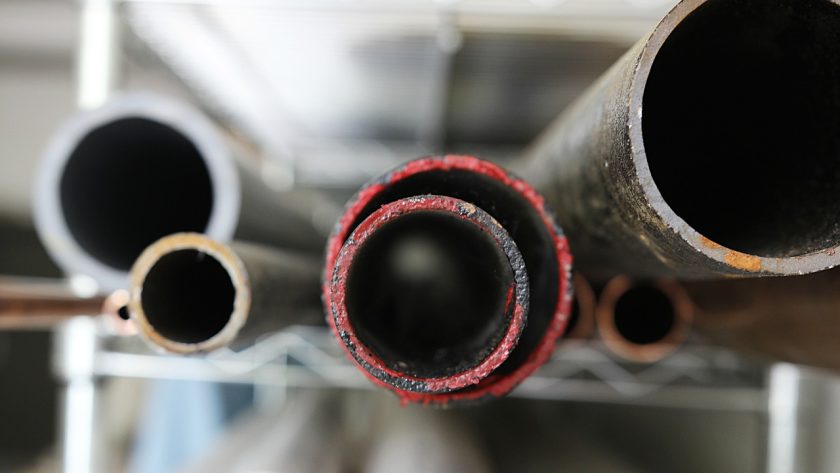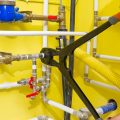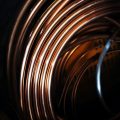Losing power from inefficient or faulty piping is an expensive accident that can most certainly be avoided. Before you install a new compressed air system, stop and ask yourself this question: “What is the best air compressor pipe for my system?”
Well, it’s not so easy to answer this question yourself, and so, I will provide you with the ins and outs of the air compressor pipe materials and which ones are best suited for various applications!
Table of Contents
- Air Compressor Pipe Materials
- Best Pipe Material for Air Compressor Lines Overall
- Best Pipe Material for Air Compressor Lines On a Budget
- Best Pipe Material for Air Compressor Lines for Hobbyists
- Best Pipe Material for Air Compressor Lines for Industrial Purposes
- Pipe Materials for Air Compressor Lines You Should NOT Use
- Air Hose Materials
- FAQs (Frequently Asked Questions)

Air Compressor Pipe Materials
There are a wide variety of piping materials that can be used for compressed air systems, these include both plastics and metals. All may offer slightly different advantages and disadvantages when compared with each other. We will focus on the following most commonly found pipe materials:
- Black steel
- Copper
- Galvanized steel
- Aluminum
- Pex
- Pex-al-pex
- Nylon
- ABS
Now let’s take a look at each of these materials!
Black Steel
Black steel, or otherwise known as black iron piping, has long been considered the industrial standard for compressed air delivery. Due to the strength and durability of the material, it has long been used in many old compressed air installations.
It’s capable of holding up against a lot of abuse, and due to it using traditional joining techniques, it can be installed by any plumber with fittings that you can easily find at a local hardware store.
Fast forward to the modern-day, and compressed air users have started to notice the many drawbacks of black iron pipes. First of all, they’re heavy, meaning that they must be anchored to be used with suspended piping systems. Iron is not the easiest metal to cut and join, and you will typically need a skilled plumber or welder to install the piping system.
The joins and welds are susceptible to leaks over time. Most importantly, regardless of your best efforts of drying the compressed air, some moisture will retain and condense in the pipes. If this occurs, black iron pipes are susceptible to corrosion, and will therefore rust. This not only weakens the pipes but also further contaminates your compressed air.
When rust is allowed to develop inside the black steel pipes, along with fouling of the airlines, it can cause blockages and certainly cause problems for any production processes.
Copper
Copper pipe is a very common material used for compressed air systems. Yes, the soldering of joints in the system can use a lot of your time and requires skill, but, the end result will be very high-quality and works sufficiently.
Copper is typically lighter than iron and easier to install than steel. With copper fittings readily available on the market, copper has become a very popular choice not only within plumbing systems but compressed air systems too.
Copper itself boasts terrific corrosion resistance and rust resistance, which in tandem with the fact that if the fittings and joints are soldered properly, you should encompass no leaks, deliver high-quality air, and have the potential to save energy costs.
One key drawback of the material is that in recent years the cost of copper has significantly risen. Copper systems are difficult to amend after their implementation unless you have a skilled plumber present. Of course, to install the copper joint and ensure they’re leak-free, you must have adequate soldering experience.
It may not be the most cost-effective option but it certainly offers great benefits.
Galvanized Steel
Galvanized steel has similar pros and cons as black steel, it is strong and holds great durability. The key difference here is that the galvanization of the steel aims to increase the material’s corrosion resistance properties, making it a popular choice for compressed air systems nowadays.
Sounds great right? Well, here’s the problem… as good as the galvanization sounds, over time this coating will degrade. As the coating (commonly zinc) degrades, it will begin to flake off inside the piping.
These flakes will undoubtedly result in similar consequences as a corroding pipe, in that they will lead to blockages and fouling of the compressed airlines. If the flakes are not filtered out, they may lead to potential safety concerns. If they are blown out of the airlines at high pressurized speeds, they may cause damage to anything in their path.
Aluminum
Aluminum has grown in the last 10 to 15 years as one of the most popular choices for compressed air pipes. Why? Aluminum offers a number of wonderful benefits in that it is a lightweight material that boasts zero corrosion and high leak resistance. It is approximately three times lighter than old black iron installations.
Aluminum can easily be manipulated making it one of the easiest metals to install and modify. Modern aluminum piping systems do not require many tools for their installation and do not need heavy supports or anchoring. It’s possible to plumb aluminum piping around an entire facility without a single bend when using their standard fittings.
Aluminum piping arrives ready to install and does not require any soldering or threading like other metals. Therefore, it can provide much cleaner air, which will lead to lower repair costs and a more efficient air supply. One downside is that just like copper, aluminum has a more expensive upfront cost. Though, many people believe that aluminum pays for itself in the long run.
Pex
PEX (cross-linked Polyethylene) pipe has become increasingly popular in recent years due to its wonderful flexibility. PEX is a version of Polyethylene (PE) where the molecular structure has undergone change by cross-linking its polymer chains to form a three-dimensional flexible network.
PEX comes at relatively cheap and affordable prices compared to the more expensive, metal piping networks. On top of this, the ability to run a long length of PEX pipe without any worry or needing additional cost fittings is certainly admirable.
The drawback here is that PEX is not actually rated for compressed air systems, yet so many people use it. PEX piping is susceptible to UV damage, and so, cannot be used in systems that are exposed to UV rays otherwise the pipe will harden and eventually crack, leading to air leaks.
Pex-Al-Pex
A version of PEX that is specifically made for ai lines is Pex-Al-Pex, or otherwise known as PAP piping. Pex-Al-Pex consists of an aluminum layer sandwiched between two layers of PEX. This combination provides the material with greater strength, corrosion resistance at the same time as being flexible and bendable.
Of course, it comes at a greater cost than PEX or other plastics but you really are paying for what you get. PAP piping is made to deal with high pressures and is widely used in residential plumbing networks, as well as compressed air systems.
PAP piping uses compression fittings or crimp-on-connector rings at their joins which allow for easy and fast connections. The aluminum layer strengthens and builds the corrosion resistance of the piping while the PEX provides flexibility.
You will be able to bend the piping with your hands in almost any direction and the pipe will remain in this fixed position. Pex-Al-Pex will be able to bend up to a 3-inch radius which can lessen the need for elbow fittings, helping you limit the amount of pressure drop in your system.
This also means that the systems are typically easy to modify. Not only that but they can be fitted into existing metal piping systems with the correct fittings. You will need to acquire specific PEX crimping tools for the crimping of a connection ring when connecting PAP piping together.
Nylon
Nylon is a good option for compressed airlines and can commonly be found in existing systems. It has an enhanced range of capabilities including its toughness, lightweight, flexibility, abrasion, and corrosion resistance, as well as being UV stabilized when compared to other plastics. Of course, this comes at a cost.
Nylon is typically more expensive than most plastic options, though, it may still be cheaper than Pex-Al-Pex but with reduced strength and durability. Nylon can be quite awkward to source the right size as they tend to be restricted.
ABS
ABS (Acrylonitrile butadiene styrene) is another suitable plastic piping option for compressed air systems, but maybe not so commonly used when compared to other options. ABS is a lightweight and easy to work with material that does not require special bracing or support.
ABS has good flexibility and kink resistance, along with great corrosion resistance. Again, ABS is typically restricted in the sizes of pipe available and it has reduced strength and durability when compared to other options. I personally would not recommend the use of ABS as there are many better options available.
Best Pipe Material for Air Compressor Lines Overall
I’d say it’s a close contest between aluminum and copper for the best overall pipe material as both offers similarly excellent properties. I am swinging towards aluminum however because it can be easily manipulated and is easier to install and modify than copper piping is.
Copper requires a sheer amount of soldering, which can be extremely difficult unless you’re trained. Aluminum doesn’t require many tools and arrives ready to install. On top of this, as raw material, aluminum is approximately 70% lighter in weight than copper, adding to the ease of transportation and installment.
Best Pipe Material for Air Compressor Lines On a Budget
If you’re on a budget, you will want to use plastic piping. Plastic pipe is cheaper than any metal, lightweight, easy to install, and boasts great corrosion resistance. The question is, which plastic pipe is the best? Well, PEX and ABS are probably the cheapest options but they aren’t necessarily the better options.
PEX, as I’ve already pointed out is not rated for compressed air and I don’t recommend the use of ABS piping. Pex-Al-Pex is more expensive than PEX and ABS but should be cheaper than any metal piping and offers the best benefits of all the plastic piping, certainly when compared to Nylon.
But, if you’re on a budget then Nylon tubing is your best option. You shouldn’t have any issues finding Nylon piping at a reduced cost to Pex-Al-Pex or any metal piping. Though it may be difficult to source the size you need, if you do, you will have a tough, lightweight material to use for your compressed airlines.
Best Pipe Material for Air Compressor Lines for Hobbyists
Now, irrespective of cost, I personally believe Pex-Al-Pex is the best pipe material for air compressor lines for hobbyists and DIYers. PAP boasts terrific corrosion resistance and has excellent flexibility which I think is important for hobbyists and DIYers.
Due to its easy and fast connections, any user will be able to set up a Pex-Al-Pex compressed air system in their garage or workshop and have the ability to modify it whenever they wish. The ability to limit elbows and joints really proves significant when considering pressure drop across compressed airlines.
If you are less concerned about the flexibility and ability to make modifications, then maybe a more permanent copper or aluminum setup is better for you.
Best Pipe Material for Air Compressor Lines for Industrial Purposes
Now, traditional black iron pipes have been used in industrial settings for many many years and even users today, in factories and hobbyists at home, still swear by the use of black iron. They claim to never have had any issues with the flaking of the zinc layer, which of course is true. It may not happen to every system but the fact it does with enough for it to be raised as an issue is enough for me and many to favor other materials.
In industrial practices today, you’re more likely to find companies using copper or aluminum pipes due to their many advantages, irrespective of their great costs. There’s not a rise in popularity for both materials use for no reason!
Pipe Materials for Air Compressor Lines You Should NOT Use
PVC and CPVC piping are significantly cost-effective and very easy to work with, and so, they have become popular in plumbing systems. There are strongly advised against use within compressed air systems as OSHA has banned them.
The reason OSHA has banned the use of PVC or CPVC piping in compressed air systems is that these materials do not have the capability to withstand high-pressure applications involving compressed air.
Not only this but they are liable to degrade when in contact with oils and lubricants which are very common in compressed air systems. This will eventually lead to fractures and splitting of the pipe, and over time not only will you undergo excessive air leakages but also a sudden, and dangerous, rupture.
Cases upon cases of injuries and even deaths lead to OSHA banning these pipes so I strongly recommended against using them, for your own and others’ safety. Please stick to plastics or materials that are approved by OSHA as oil-resistant and safe to use.
Air Hose Materials
When it comes to selecting the right air hose for your compressed air system, you will typically have the choice between the following four materials:
- PVC
- Rubber
- Polyurethane
- Hybrid
Now, let’s take a look at each in more detail!
PVC
PVC air hoses are likely the most affordable air hoses available on the market. Their design consists of a PVC-compound inner tube which is surrounded by a polyester spiral outer tube, together with allowing the hose to hold its shape.
In comparison to rubber hoses, PVC hoses are typically stiffer, which can lead to difficulties in coiling and uncoiling the hose. Though these hoses are affordable, they also tend to kink, and can easily become inflexible in cold weather conditions.
Rubber
Rubber air hoses are probably the most common of all air hoses. They’re made from synthetic rubber which is reinforced with yarn. Rubber hoses are known for their durability, and the fact they do not kink or coil easily.
This makes rubber very easy to work with, even if working in cold temperatures. Though they are more expensive than other materials, they rarely leak. On the odd occasion that they do leak, they are easy to fix. Due to the tackiness of the material, it collects dirt as it is dragged across the floor.
Polyurethane
Polyurethane hoses have a similar appearance to PVC hoses, an so, they’re often confused. Polyurethane performs far better than PVC, they’re lighter and more flexible. They are however suspectible to kinking as they’re not as flexible as rubber.
Compared to other hoses, Polyurethane have a relatively high cost and are only really suitable for framing and roofing projects due to their smooth outer layer which helps them glide across rough surfaces.
Hybrid
Hybrid hoses as you may have guessed, are a combination of rubber, polyurethane, and PVC. This blend gives you qualities similar to rubber but at a lighter weight.
Hybrid air compressor hoses also boast great durability and flexibility which makes them suitable for almost any task. After extended periods of use, the hybrid hose may begin to kink, unlike rubber hose.
FAQs (Frequently Asked Questions)
Overall, aluminum is the best pipe to use for air compressor lines due to its fantastic properties. It is lightweight and easy to install with minimal tools, along with boasting great resistance to corrosion.
If you can afford it, and are capable of installing it, I would strongly recommend using metal piping as this is the best choice. If you also prioritize clean air then I would recommend using either copper or aluminum. Aluminum will be the easier of the two to install.
Pex itself should not be used for compressed air because it is not rated for that use. There are very few Pex pipes that are stated as being sufficient to use with compressed air as a lot of them will not specify. It is therefore important to check the pressure ratings of the pipe and compare them with your air compressor. Pex-Al-Pex, however, is specifically designed for compressed air systems.
You have multiple options of air pipes you can use for your compressed air system. Some of your options include copper, aluminum, black iron, galvanized steel, nylon, pex-al-pex, or ABS just to name a few!
If you have any questions about the best pipe for air compressor lines, please leave a your question below, so that someone can respond to you!





